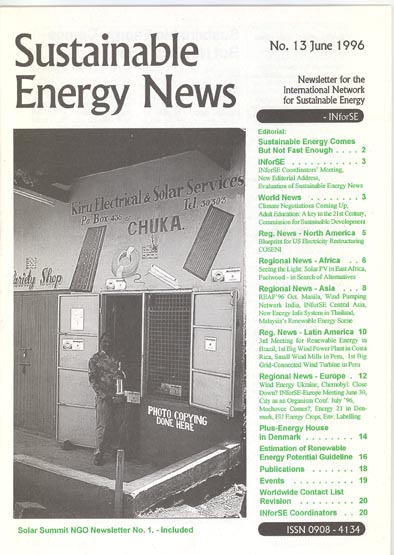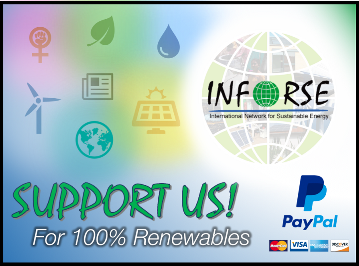|
|
|
|
|
|
|
|
|
|
|
|
|
|
|
|
|
|
|
|
|
| Follow Us: |
| Seeing the Light: Solar PV in East Africa | |
| By Ann Heidenreich, NGONET, Kenya. | |
|
Contrary to what many people think, solar PV is not too expensive for ordinary folk. Hundreds of thousands of rural households in East Africa now pay $5 to $10/month or more for kerosene for lighting and drycell batteries for radios, and small businesses are paying significantly more. These are potential customers for solar PV systems. Small solar systems pay for themselves over a period of one to three years, and after that, savings are significant. In addition, the quality of lighting is far better and the house is free of unhealthy kerosene fumes. I visited a small business (SuperLife Bar) in Komolo on the Maasai Steppe in Tanzania in early April that had been using 20 litres of kerosene/week at TSh 400/litre (US$16/week; $64/month; $832/year). Late last year, the owner, Mr. Lengai, bought a solar PV system for about $1,000. In just over a year from the time of purchase, he will have recovered the cost of his system and after that, costs for lighting and music in his establishment will be drastically reduced. With the recent dramatic rise in production and drop in costs, solar PV is already on the market and powering lights and radios in tens of thousands of rural homes in East Africa. There are small entrepreneurs selling PV systems in many villages, and local manufacturers producing system components. Solar PV has become a new fashion in donor, government and NGO circles. There is a danger that the influx of donor funds will undermine local entrepreneurs who are already in the business. New projects must build on work that has already been done. Mass dissemination of any technology is best done through the market. Donor interventions in the field of solar PV should be aimed at building an infrastructure for market dissemination of solar PV. Support is appropriate for training, demonstration, credit, design, policy formulation and networking. KARADEA Solar Training Facility, Tanzania, has regular courses supported by EAA (see issue no.11). The next course is 8-28 July 1996. The 4 As for customer satisfaction: Awareness Most people won't buy what they have never seen. Donor funds could be channelled into small, well-maintained demonstration systems in public buildings such as schools, hospitals, libraries and offices. These should be decided upon by local groups, purchased locally, installed and maintained by local technicians. |
|
| Availability | |
|
Local businesses should be on hand in rural villages to design, deliver, install and maintain PV systems and to instruct customers in operation and maintenance.<%-2> <%-3>Donor funds are needed to establish and operate solar training centres, provide scholarships for trainees, and support credit schemes to start-up small businesses, with the aim of having an electrical shop in every village. |
|
| Affordability | |
|
Although some people have sufficient cash to buy solar PV systems up front, many people do not. Reduction of import duties, downsizing (not downgrading) of systems to match rural financing schemes are needed to enable many more people to buy solar PV. While systems should be affordable, they should not be given away free or at subsidized rates that undercut local companies. |
|
| Appropriateness | |
|
Most solar equipment on the market today is not designed for the rural African market. Development banks should give credit to companies for market surveys and redesign of equipment. In Kenya, various ways to finance solar PV are being tried, supported by the World Bank (ESMAP/GEF/IFC) and/or the Ashden Trust, and implemented by Kenya Rural Enterprise Programme and Energy Alternatives Africa (EAA). Some examples: - "Solar Energy for Rural Kenyan Businesses" provides loans to qualifying businesses and community groups together with required training and support to establish small, solar-based businesses. - "Testing of Financing Mechanisms for Solar Equipment in Rural Villages" will be a 3.5-year project. - Several projects are underway to field test solar lighting and radio systems, particularly solar lanterns. A number of small local companies sell the lanterns at subsidized rates and gather information on customer response. Many of the lanterns being sold are designed for the US camper market, not for everyday use in rural African homes. These surveys will provide valuable feed- back to manufacturers on how to design for the African market, where potential sales are in the millions of units. - A workshop entitled "Building Renewable Energy Infrastructure in Africa" was held for Development Officers from 18 districts in Tanzania, Kenya and Uganda, 1-3 April 1996 in Arusha, Tanzania. The report of the workshop includes a list of 70 solar PV businesses in East Africa. Copies are available from EAA. More info: Ann Heidenreich, NGONET, PO Box 76406, Nairobi, Kenya. Ph/fax: +254-2-729447; email: annh@chasque.apc.org; or Mark Hankins, EAA, PO Box 76406, Nairobi, Kenya. Ph/fax: +254-2-565616; email:energy.africa@tt.sasa.unon.org. The article is compiled from an article in EcoNews Africa (18 April 1996) by Ann Heidenreich, and a paper by Ann Heidenreich and Mark Hankins presented at the World Bank Donor's Roundtable on Energy and Development, April 1996 in Washington DC. |
|

| |
| Published in Sustainable Energy News |
|
|
Go back to main page of ISSUE #13 Sustainable Energy News (16 pages) (1996-06-30) 
|
|
| Contact | |
| |
INFORSE Secretariat Klosterport 4F, 1. floor DK-8000 Aarhus C Denmark Phone: +45 86 22 70 00 Twitter: INFORSE_org Facebook: INFORSE Web: inforse.org E-mail: ove@inforse.org |
